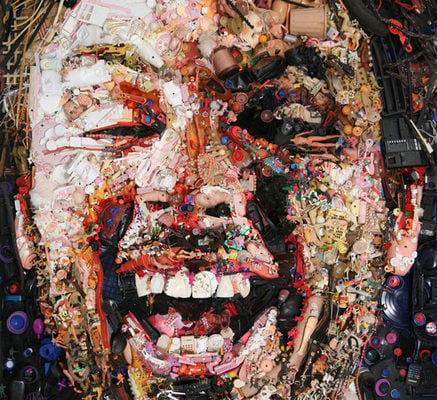Just a block from the Armory Show lies the (un)SCENE Art Show, a smaller, more artist-friendly affair that opened today, March 4, and will run through March 8. The goal of the scrappy satellite fair? To remind art-lovers that the work itself is more important than the elaborate trappings of the jet-setting, see-and-be-seen art world.
The (un)SCENE is the spiritual successor of the (un)FAIR, held by Mikel Glass and Jen Wallace during the past two Armory Weeks. After the pair split, Glass wasn’t sure that he had another art fair in him, but as the first week in March drew closer, he felt the itch to try again.
“If I had a religion it would be art,” Glass told artnet News, lamenting how commodified the contemporary art world has become. Organizing the (un)SCENE as a counterpoint felt “sort of like a responsibility.”
When Glass finally decided to hold the fair at end of December, he had very little time to pull together an event of this magnitude. He credits a team of “battle-hardened collaborators driven by pure energy” for his success in making it happen. The space, formerly a “totally fallow factory building,” was secured just three-and-a-half weeks ago.
At the time of our visit, workers were still drilling holes in the cement block walls to hang a pair of Giovanni Battista Tiepolo frescos, displayed on either side of a large contemporary painting. Not yet completely unwrapped and leaning tantalizingly against another wall was Giovanni Battista Beinaschi’s The Martyrdom of Saint Peter. Dating to approximately 1660, the piece spent nearly 200 years in the collection the Princes of Liechtenstein, and has recently undergone conservation. “I’m dying to see it in person,” sales representative Gary Krimershmoys told artnet News of the sure-to-be-showstopping canvas.
The integration of such historic works with contemporary pieces is one of the fair’s most unique components. “We want to recontextualize the Old Masters,” explains Glass. “They should not have to be separate from artists trying to create their own history.”
As visitors cross the threshold to step inside the (un)SCENE, they will a pass under a massive, low-hanging sculpture by Jason Hackenworth. This otherworldly piece, created from about 7,000 pink, orange, and white balloons, forces taller visitors to duck their heads, and serves as fair warning to expect the unexpected. Just past the entry, the coat check is on the left, to the right, quite literally, is the ego check.
Hackenworth will also outfit two people in tubular balloon exoskeletons, and send them on a mission to gain entrance into the big art fairs, so keep an eye out for these alien-like costumes at the nearby Armory Show and VOLTA.
For artists like Jerry Meyer, showing at the (un)SCENE fair is a welcome departure from the mainstream fair culture. “There are no galleries buying $30,000 booths. No one is trying to sell you art as an investment,” he told artnet News.
Meyer’s contribution to the fair, Understanding My Great-Grandfather’s Attempts to Turn Sexual Energy into Electricity to Power Small Machinery Based on the Principles of Sigmund Freud and Nikola Tesla, is a cross between an art installation and a historical museum exhibition. Through the elaborate multimedia room, Meyer has created a richly embroidered fictional tale of his ancestor’s life. He describes the piece as “fabricating an authenticity so elaborate it’s almost believable.”
Other highlights include Chaney Lane Trotter’s life-size woodland diorama, Will Kurtz’s large-scale newspaper horse sculpture, and Jackie Mock’s wunderkammer-like presentation of mundane objects like The Entire Life of This Pen, a framed pen mounted on a sheet of intense black scribbles.
The (un)SCENE attempts to put the focus back on art appreciation—”often lost in favor of how much it’s worth,” Glass laments. “I’m really hoping the fair is an emotional experience for visitors.”
Nevertheless, Glass is quick to point out that “we’re not anti-consumerist.” He fervently hopes that visitors will “fall in love with an object and take it home.”
The (un)SCENE Fair is on view Wednesday–Sunday, 11 a.m.–8 p.m., this week at 549 West 52nd Street.
Want more Armory Week coverage? See The Go-To Guide for Armory Week 2015 Art Fairs, Your Art Agenda: 12 Exclusive VIP Events Not To Miss During Armory Week, Spring/Break Art Fair Is Bigger, Flashier, and Scrappier Than Ever, and Independent Art Fair Offers a Stylish Chelsea Haven During Armory Week.
